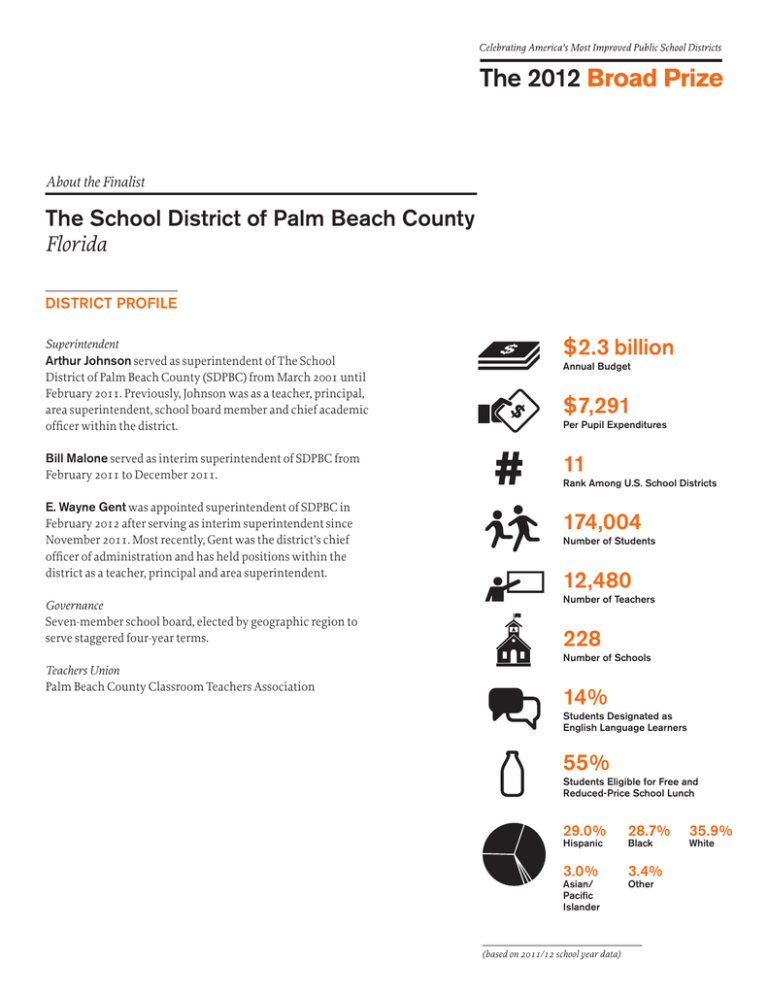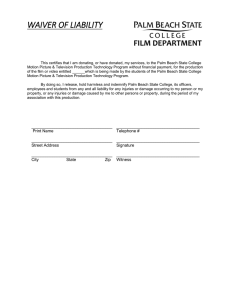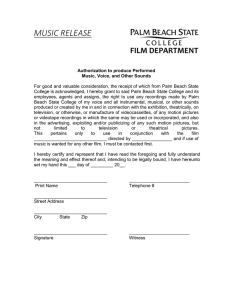The School District of Palm Beach County
advertisement

About the Finalist The School District of Palm Beach County Florida DISTRICT PROFILE Superintendent Arthur Johnson served as superintendent of The School District of Palm Beach County (SDPBC) from March 2001 until February 2011. Previously, Johnson was as a teacher, principal, area superintendent, school board member and chief academic officer within the district. $2.3 billion Bill Malone served as interim superintendent of SDPBC from February 2011 to December 2011. 11 E. Wayne Gent was appointed superintendent of SDPBC in February 2012 after serving as interim superintendent since November 2011. Most recently, Gent was the district’s chief officer of administration and has held positions within the district as a teacher, principal and area superintendent. Governance Seven-member school board, elected by geographic region to serve staggered four-year terms. Teachers Union Palm Beach County Classroom Teachers Association Annual Budget $7,291 Per Pupil Expenditures Rank Among U.S. School Districts 174,004 Number of Students 12,480 Number of Teachers 228 Number of Schools 14% Students Designated as English Language Learners 55% Students Eligible for Free and Reduced-Price School Lunch 29.0% 28.7% 3.0% 3.4% Hispanic Asian/ Pacific Islander (based on 2011/12 school year data) Black Other 35.9% White STUDENT ACHIEVEMENT A greater percentage of Hispanic students reach advanced academic levels in Palm Beach County than in other Florida districts—and at faster rates. In 2011, the percentage of Palm Beach County’s Hispanic students performing at the highest achievement levels (Levels 4 and 5) ranked in the top 30 percent statewide compared to Hispanic students in other Florida districts. This was the case in science at all school levels (elementary, middle, high school) and in middle and high school reading and math. Between 2008 and 2011, Palm Beach County also was more successful than at least 70 percent of Florida districts at increasing the percentage of Hispanic students who performed at the highest achievement levels. This was the case in middle and high school reading, math and science. For example, the percentage of Hispanic students performing at the highest achievement levels increased by 9 percentage points in middle school science, while the average increase for other Florida districts was just 4 percentage points during that period. Palm Beach has a higher graduation rate than other large urban districts and bigger increases over time for black and Hispanic students. Palm Beach County’s 2009 graduation rate—74 percent, as shown by the average of three nationally recognized graduation rate estimation methods—ranked in the top 20 percent of all 75 Broad-Prize eligible districts. In addition, between 2006 and 2009, Palm Beach County’s black student graduation rate increased 21 percentage points, Hispanic student graduation rate increased 13 percentage points, and the district’s overall graduation rate increased 18 percentage points. Palm Beach had a greater increase in the percentage of black students participating in college readiness exams than other urban districts. Between 2008 and 2011, participation rates by black students in Palm Beach County on Advanced Placement exams increased 8 percentage points—an approximate 3 percentage point increase on average per year. This improvement rate ranked in the top 10 percent of all Broad Prize-eligible districts. 02 The School District of Palm Beach County EXEMPLARY PRACTICES RELATED TO STUDENT ACHIEVEMENT The district empowers teachers to succeed by providing them with access to a cohesive, comprehensive and user-friendly system for assessing and reporting student performance. Teachers and administrators access this data to make instructional improvements. and even why they got them wrong by looking at the answers students selected. Teachers, who often discuss the data in groups and brainstorm ways to apply it in the classroom, then shift their lesson plans in light of what the reports reveal. The managers of the district’s “education data warehouse” have taken great pains to make student achievement information easily accessible to teachers and administrators—and to deliver it in an easy-to-understand format that allows for effective decision-making. In an instant, teachers can see longitudinal data about their students, and identify where they stumble and where they shine. They can quickly identify what educational services and interventions a student has received, and zero in on the ones that worked, as well as those that did not. The district holds school leaders, teachers and administrators responsible for student performance and provides intensive assistance to help those who need it grow professionally. Teachers and administrators consistently rate the warehouse high in terms of usability, accuracy and timeliness. The system tracks student grades, credits and grade point averages, assessment results, attendance records, disciplinary incidents and college readiness exam scores, such as the PSAT, SAT and ACT. Information in the warehouse is updated daily by dedicated central office staff and serves as an excellent tool for tracking a student’s progress toward graduation. Among other things, the warehouse data can be used to analyze the strengths and weaknesses of individual students, groups of students, teachers, schools and the entire district. The reports are issued in a color-coded format that quickly highlights any problems that require immediate attention. The data can also be broken down so that individual schools can see how they are performing compared to other schools with similar demographic characteristics. For example, a third-grade teacher in a particular school could run reports that show how her students are doing compared to the class next door, which students respond to which types of instructional strategies, and whether her reteaching succeeded in helping students learn the information. Teachers across the district have been trained to run reports themselves, and the warehouse is used frequently. During the 2010-11 school year, district personnel produced more than 1.7 million reports. Most teachers access the data warehouse at least once a week to analyze student progress and identify those who need extra help. The assessment data can be viewed in minute detail to show how students perform on individual test questions. Teachers can see which types of questions students got wrong 03 The School District of Palm Beach County The district has put in place an aggressive plan to boost performance in its most challenged schools, in particular those that have received a D or an F rating from the state of Florida. In a sprawling district with extremes of wealth and poverty, many of these schools are located in far-flung locations of limited means. Passionate teachers have gravitated toward these turnaround efforts, primarily because they care deeply about equity and opportunity, and the district has provided extra incentives and professional support to lure them to challenged schools, including performance bonuses and mileage payments for those who make a long drive to a school far from home each day. The district also lowered class sizes in these schools and sent reading and math specialists in to help. About 1,000 coaches have been trained to work in these schools, and they meet monthly to discuss areas of common concern, best practices and ways to use education data warehouse information to pinpoint areas in which teachers need the most help. While all new teachers in the district are assigned mentors, new teachers in low-performing schools are given a second coach to provide them with additional modeling and individual feedback. In some cases, schools are also assigned new principals based on their records of high performance and skills at turning around challenged schools in other districts. Existing principals are paired with mentors. District staff spend a lot of time in these schools offering support and feedback. They also closely review each school’s performance data and discuss it with teachers and principals. While the district makes abundant resources available to support school-level staff, it also expects results. Principals who don’t raise their school’s test scores after two years are replaced. Teachers in the turnaround schools are required to establish common planning time each week in order to brainstorm about how to improve upon teaching and learning strategies and techniques. Skilled school-based facilitators work with these professional learning communities to guide them in how to use data analysis to shape instructional planning. The district has created a positive school culture that encourages students to focus on learning. Under an approach the district calls “single school culture,” The School District of Palm Beach County has developed a behavioral management system that allows teachers to focus on learning without constant arguments about rules and regulations. Under this approach, teachers and administrators in an individual school come to an agreement about everything from cell phone use to ear phones to dress codes to rules for handing in homework. They review all rules at the beginning of the year and pledge to follow them strictly. Students are also made aware of the rules and consequences from day one and soon learn that they are strictly enforced. participate in an intensive two-year professional development program. Each early-career principal is matched with a mentor for two years and participates in monthly professional development sessions to share concerns and receive additional guidance. Principals report that they become well-prepared for the routine work of managing schools and have networks of seasoned administrators that they can tap for any leadership or operational challenge that arises. In addition, all principals and assistant principals attend a summer camp where they learn about a wide range of effective leadership and instruction practices and often hear from state- or nationally recognized speakers on topics ranging from cultural sensitivity to AP achievement to English language learner leadership. The idea is to consistently and clearly communicate the rules to students and make sure all teachers are reading from the same script so that student expectations are clear. This prevents students from playing one instructor off of another or encouraging popularity contests where the most lenient teacher wins student fans. The resulting consistency encourages an atmosphere of collaboration and teamwork among teachers, who report that they feel like they’re all in it together. As a result of the single school culture, disciplinary issues related to minor infractions have decreased and teachers report that they spend far less time on classroom management and more time on instruction. The district develops and sustains effective leaders who are highly visible and expert at solving instructional challenges. Principals and assistant principals are highly visible across the district, and many regularly drop in to classrooms to conduct informal walkthroughs. District leaders visit schools often, especially those that have received low grades on the state’s school report cards. Leaders at schools across the district say that central district staff are accessible and responsive to their requests for support. Palm Beach also provides a wide array of development programs for instructional leaders at different points in their career. Experienced principals who are new to the district undergo a one-year orientation process, and first-time principals 04 The School District of Palm Beach County The Eli and Edythe Broad Foundation 10900 Wilshire Boulevard Los Angeles, California 90024 t 310.954.5050 f 310.954.5051 broadprize@broadfoundation.org www.broadprize.org



